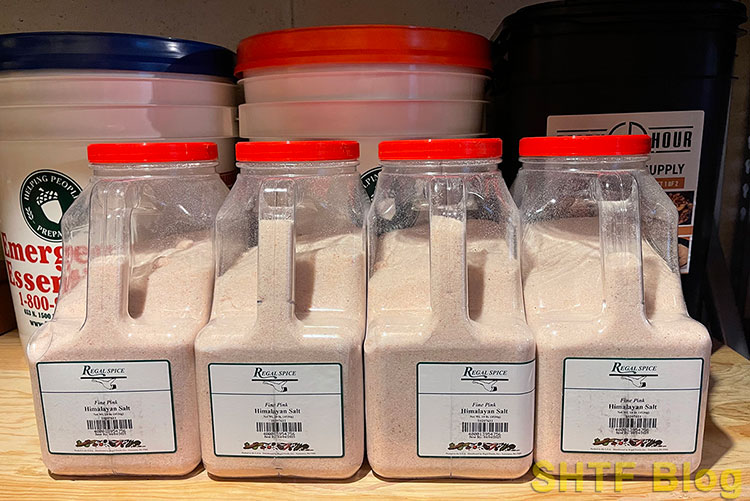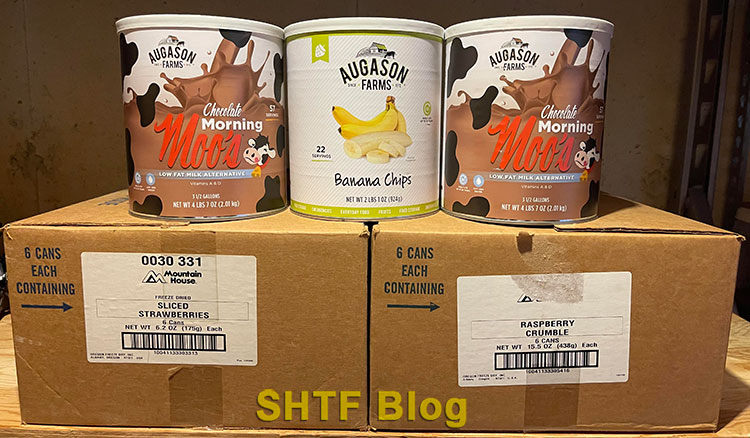
Appetite fatigue means being so tired of eating the same food over and over again that you can’t handle eating it again.
Not accounting for appetite fatigue in food storage is a mistake I see preppers make time and again. I get it. “Stock rice and beans” is what people say. It’s cheap and easy, and the two form a very healthy combination. But rice and beans over and over every day?
Once appetite fatigue sets in, forcing food down can become a real challenge. This is not the situation you want to be in post-collapse.
The average healthy adult can usually overcome this when eating means the difference between life and death. In fact, I’m not very worried about appetite fatigue for myself. I have a pretty strong will and stomach. It’s the rest of my family that I worry about!
Appetite fatigue in a long-term crisis could be a serious problem for seniors and children. They may not have the will to force down food. Any parent knows this. Imagine the stress trying to get your two-year-old child, who is rapidly losing weight, to eat yet another bowl of rice and beans.
Fortunately, prepping for appetite fatigue in food storage is actually quite easy. I’ll explain how in a moment.
History Provides an Example
There have been different times in history where a famine or economic crisis forced people to rely on using root crops or tubers for their main foods. If you ever talk to someone who went through a period like this in their life, you’ll hear them say they still can’t touch the foods they depended upon back then.
Perhaps it’s more psychological than anything. The very foods that caused their appetite fatigue were ones that ended up sustaining them through that difficult part of their life. Yet they don’t have a sense of gratitude about them; only disdain.

One example of appetite fatigue happened in Ireland: the big Irish Potato Famine from 1845-1851. Potatoes were the mainstay of the diet in Ireland in the 17th century. The potato had transformed Ireland from an underpopulated island of 1 million in the 1590s to 8.2 million in 1840, making it the most densely populated country in Europe.
Between 1750 and 1810, the poorer classes of people were dangerously reliant on it as a staple for most of the year. It was easy to grow, even in poor conditions, and reproduced itself underground.
Potatoes were eaten for just about every meal. The people parboiled the potato, leaving the core undercooked, which created a second digestion period and staved off hunger for longer periods of time. Helpful for the worker!
There were different potato dishes for different classes of people. The wealthy people and aristocrats ate completely different potato dishes than the poor.
What did they eat? Probably recipes like these:
- potato pancakes
- baked potatoes with different trimmings
- mashed potatoes
- fried potatoes
- potato casseroles
- potatoes as a side dish in a meal
- potatoes with cheese
- potato soup with many variations
Let the potato famine be a lesson that we can learn from. Plan for it!
3 Ways to Fix Appetite Fatigue in Food Storage
In the historical example above, families would eat potatoes with dairy products, produce, and occasional pieces of bacon or pickled herring. Wealthier families would sometimes eat potato puddings, made by adding sugar, spices, and saffron.
We can derive some lessons to use for our food storage efforts to help assure that in a prolonged disaster we can keep eating from our storage with minimal appetite fatigue. Consider the following suggestions when planning your prepper food pantry.
1 – Stock Diversity
It should come as no surprise that the simplest way to address appetite fatigue is to include enough foods in your long-term storage that you can enjoy different meals. Diversity is the spice of life, no? There are so many long-term foods available today that stocking diversity is easier than ever.
That said, try eating freeze-dried chicken soup one day, freeze-dried beef stew the next day, freeze-dried macaroni and cheese the next day, and so on. You’ll feel appetite fatigue set in just the same.
You want diversity of foods not just in the actual dishes, but in the types of food stored.
This is why I never advise people just buy crates of freeze-dried foods as their sole source of food during a long-term crisis. Short-term? Sure, that works fine. Long-term it doesn’t.
On the flip side, I always advise people to have some freeze-dried foods stored. With a shelf life of 30+ years, they’re the ultimate “set it and forget it” food storage product.
Start by building out your pantry with the foods your family already eats on a daily basis. Then add buckets of stored rice, beans, pasta, etc. Then mix in some freeze-dried foods, maybe some MREs for your bug out bag, etc.
Want more info? See my article on how to store rice, how to store pasta, and search for bulk freeze-dried food deals to buy.
2 – Stock Spices
If diversity is the spice of life, then spices are… I’m not sure, other than essential in food storage!
It’s easy to forget spices when you’re focused on accumulating raw calorie count for a crisis, but ignoring them entirely is a mistake.
What makes a world of difference to a bowl of rice? Salt and pepper! This is precisely why I’ve written articles on how to store salt and how to store pepper. The best thing about stocking them is that their shelf-life is almost infinite. Neither will go bad. Salt will last forever. Peppercorns, when stored properly, can last 4-5 years before they begin to lose flavor.

There are many more spices than just salt and pepper, of course. Check out my article on top spices preppers should stock.
3 – Stock Sweets and Treats
Want to get calories into children 2 months after a collapse? Hand them a glass of chocolate milk!
While not quite true chocolate milk, I bought a case of Augason Farm’s Chocolate Morning Moos when my kids were much younger for this very purpose. Fortunately, we never had to use them in a crisis; but the good news is, with the 30+ year shelf life, they’re still good!

The pic above illustrates just a few of the “fun foods” I have stocked: sliced strawberries, raspberry crumble, chocolate milk alternative, and banana chips. Having just a few fun foods can go a long way.
Check these online retailers for their long-term storage fun food offerings:
“Sweets and treats” can include any food or drink that will put a smile on your face post-collapse. For 7 in 10 Americans, this means stocking one thing in particular…
COFFEE!
I have written on how to store coffee long-term, so if you love coffee as much as I do, read it! It involves stocking green coffee beans and having the means to roast them.
If that sounds like too much work, go the easy route and just buy Franklin’s Finest Survival Coffee. Read my taste test. It’s not bad for coffee with a 25-year shelf life!
Nutritional Benefits
Stocking a diversity of foods will do more than reduce your chances of facing appetite fatigue – it’ll improve your health!
Every limited diet will create nutritional deficiencies. Think about seniors who live on toast and tea because they cannot prepare their own meals and care for themselves. Many take medications that interfere with their appetite. They can end up with an electrolyte imbalance that can lead to bigger problems.
Eating the same thing over and over again kills your nutritional status.
Research on the Subject
Although there I couldn’t find any studies specifically on the subject of appetite fatigue, there are smaller studies where people consumed foods provided by the research team for about 30 days.
In one NASA food study designed for astronauts, a group of people were asked to assess food choices over an 81-day menu. Food fatigue was experienced toward the end of the study, especially with the frozen food entrees.
The team commented that a 20-day menu cycle with fewer recurring foods might have been better than an 81-day menu. They followed the menu pretty closely but did change some of the meals, switching foods to different times or different days, and adding butter to low fat items. Their appetite fatigue came into play with the bean burritos and grilled cheese sandwiches.
You Provide the Best Research
If you think about it, you have almost certainly experience appetite fatigue, if even briefly.
I have a friend who likes to cook. He’s good at it. He ran a food truck for a few years serving pulled pork at fairs and festivals. He ate a lot of pulled pork during that time. He hates it today because he had so much for so long.
If you’ve ever wondered what’s for dinner and feel like nothing sounds good – that’s appetite fatigue! Then magnify that times 10 and that’s what you’ll face in an apocalypse.
Creative Recipes Can Help
Knowing how to actually work with your food store can make a big difference. Plan to cook from it, and know how to deliver the same foods in slightly different ways, much like the Irish did with potatoes.
Let’s keep going with rice and beans. When you have to survive on what’s in your pantry, you are going to need variety. And now is the best time to learn what to do about varying up recipes.
Take a look at this chart for how to vary rice and bean dishes:
| Recipe | Highlights of the Recipe |
| Latin American-Style Red Beans and Rice | Uses sodium-free tomato sauce and adobe seasoning, a Puerto Rican dry spice blend |
| Italian Style Vegetarian Rice and Beans | Add sautéed tofu or seitan to give it more protein. Use cannellini beans. |
| Brown Rice and Red Beans | Cook your brown rice and red beans first, then add sherry and balsamic vinegar. |
| Middle Eastern Rice with Black Beans and Chickpeas | Your flavoring is cumin, coriander, turmeric, garlic, cayenne pepper, cilantro, parsley, and pine nuts. Use ground turkey as well. |
| Spanish Chicken and Rice | Chicken thighs cooked in Spanish-flavored rice with Spanish Chorizo, garbanzo beans and green olives |
| Asian Style Fried Rice and Beans | Brown rice and garbanzo beans plus cilantro, lime and pineapple. (Can add ginger, too) |
| Mexican Beef and Rice Skillet | Ground beef, black beans, white rice, fire-roasted tomatoes, shredded cheddar and Monterey cheeses. Great inside a tortilla. |
| Mom’s Authentic Puerto Rican Rice and Beans | Pinto or pink beans and basmati rice are used – add olives and pork, too. |
| African Rice and Beans | Spicy flavorful rice and beans flavored with onions, thyme, smoked paprika, garlic, and crayfish. |
| Cowboy Beans and Rice | Rice and white beans cooked with onions, chili powder and chopped chilies. |
| Jamaican Red Beans and Rice | Garbanzo beans and white rice with coconut milk, thyme, scallions, and scotch bonnet peppers |
| Scandinavian Navy Bean and Rice Stew | Navy or kidney beans with long grain rice flavored with lemon juice and fresh dill |
| Vietnamese Sweet Rice and Bean Pudding | Black-eyed peas and sticky rice, sugar, coconut milk. You may add tapioca, lotus seeds, crunchy seaweed, or cinnamon and vanilla. |
| Peruvian Beans and Rice | Canary beans mixed with leftover rice and fried in a skillet to turn it into a large patty. Add salsa to it after serving. |
| South Louisiana Style White Beans and Rice | Add your smoked or andouille sausage, Creole seasoning, and onion, celery and bell pepper. Serve with cornbread. |
| Greek Chickpeas and Rice with Lemon and Tahini | Add lemon and tahini. |
| Vegan Indian Biryani | Basmati rice, green beans, golden raisins, pistachios, turmeric, star anise and cardamon pods |
| Valencian Paella | Chicken, artichokes, lima and green beans |
| Red Bean and Walnut Mochi Cake | Made with rice flour; add red bean paste to the cake batter. |
Again – diversity works!
By varying the types of rice, beans, and flavors you use, you won’t suffer from appetite fatigue. Instead, you’ll be anxiously awaiting the next new variation with hopeful expectation.
Okay, that might be overly optimistic 3 months after all your favorite restaurants closed up, but different recipes will surely help.
What to Do Now
Now that you have this new information, it’s time to put it into practice. One of the best ways to do that is to delegate someone to find recipes for beans and rice, copy them to a document, save it on your bug out USB, and start experimenting.
What are you stocking to combat appetite fatigue? Which fun foods do you store?

1 comment
Excellent article! It’s something people don’t think about. If you’ve ever eaten plain rice & beans (I have) you realize how FAST appetite fatigue would set in. Every time I go to the dollar store I grab some extra spices. Yeah, they’re probably not the highest quality & certainly not organic, but they’ll make rice & beans edible & most aromatic herbs don’t require pesticides so not being organic isn’t a big deal. I also look for jars of jalapenos, other peppers, green olives, mushrooms, jam/jellies, etc. Dollar Tree carries an amazingly high quality brand (Pampa) of those kind of things that I prefer over more expensive brands. I also keep an eye out for odd things like ginger paste, coconut milk, Thai sauce mixes, etc. I figure that will give me something interesting to experiment with when appetite fatigue does set in. And I discovered that coconut milk, powdered sugar & butter powder makes the BEST frosting ever. Another thing to do is buy extras of your emergency foods & experiment with recipes. Most people are used to opening a box & following the directions printed on it. It’s a very different situation trying to make palatable food from bulk rice & dehydrated vegetables, ESPECIALLY if you are now cooking over a twig fire in the back yard. And you MIGHT discover some treasures, like Hoosier Farms white cheddar powder that puts all other Mac & cheese mixes to shame. This allows you to use higher quality pasta & enjoy a tastier product. You can also create & package your own bug out meals at a fraction of the price once you perfect your recipe. One last tip: Write expiry dates on the front of cans & jars in your pantry in fat Sharpie when you bring them home. This helps you rotate your pantry items without the time consuming search & squint. Especially helpful if the lights go out! It also brings foods that need to be used up to your attention. When I’m pantry shopping, I will look for products that have a far off expiry date & grab extras of those. Great blog. I’m enjoying your concise information without the life story some blogs insist on including in EVERY SINGLE ARTICLE.